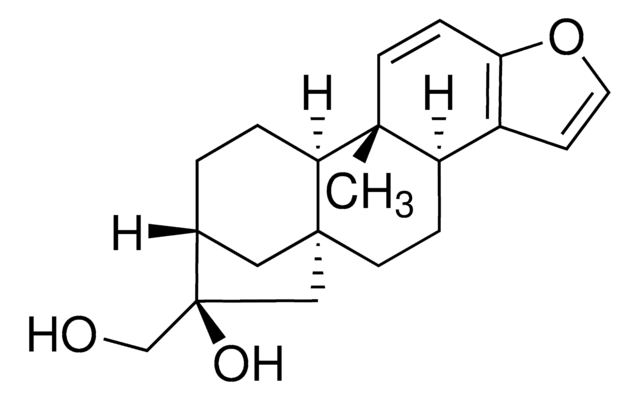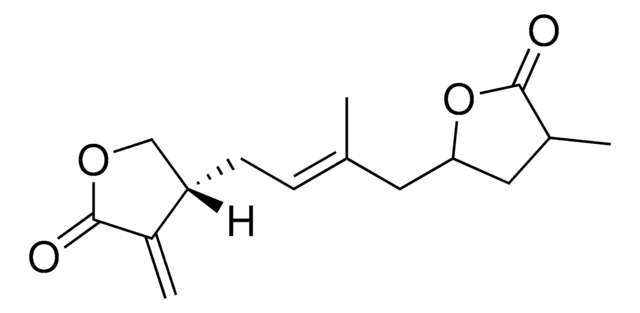Alle Fotos(2)
Wichtige Dokumente
C1305
Cafestol acetate
≥98%
Anmeldenzur Ansicht organisationsspezifischer und vertraglich vereinbarter Preise
Alle Fotos(2)
About This Item
Empirische Formel (Hill-System):
C22H30O4
CAS-Nummer:
Molekulargewicht:
358.47
MDL-Nummer:
UNSPSC-Code:
12352205
PubChem Substanz-ID:
NACRES:
NA.79
Empfohlene Produkte
Assay
≥98%
Form
powder
Methode(n)
HPLC: suitable
Farbe
white to off-white
Lagertemp.
2-8°C
SMILES String
CC(=O)OCC1(O)CC23CCC4c5ccoc5CCC4(C)C2CCC1C3
InChI
1S/C22H30O4/c1-14(23)26-13-22(24)12-21-9-5-17-16-7-10-25-18(16)6-8-20(17,2)19(21)4-3-15(22)11-21/h7,10,15,17,19,24H,3-6,8-9,11-13H2,1-2H3
InChIKey
PTGGVIKFNQSFBY-UHFFFAOYSA-N
Anwendung
Cafestol acetate has been used to determine the effects of coffee on heat shock response (HSR).
Biochem./physiol. Wirkung
Cafestol is a coffee-specific diterpene. It has anti-carcinogenic and anti-inflammatory activities. Cafestol stimulates apoptosis in cells associated with colorectal and renal cancer (Caki cells). It is used to study mechanisms of anti-oxidation related to hydrogen peroxide induced oxidative stress and DNA damage. Cafestol increases the level of glutathione (GSH), by stimulating γ-glutamylcysteine synthetase. It acts as a chemopreventive agent by inducing cytochrome P-450.
Sonstige Hinweise
Furan-containing diterpene from green coffee beans.
Lagerklassenschlüssel
11 - Combustible Solids
WGK
WGK 3
Flammpunkt (°F)
Not applicable
Flammpunkt (°C)
Not applicable
Persönliche Schutzausrüstung
Eyeshields, Gloves, type N95 (US)
Hier finden Sie alle aktuellen Versionen:
Besitzen Sie dieses Produkt bereits?
In der Dokumentenbibliothek finden Sie die Dokumentation zu den Produkten, die Sie kürzlich erworben haben.
Pablo Muriel et al.
Fitoterapia, 81(5), 297-305 (2009-10-15)
Coffee consumption is worldwide spread with few side effects. Interestingly, coffee intake has been inversely related to the serum enzyme activities gamma-glutamyltransferase, and alanine aminotransferase in studies performed in various countries. In addition, epidemiological results, taken together, indicate that coffee
Ting Shen et al.
Biological & pharmaceutical bulletin, 33(1), 128-132 (2010-01-05)
Coffee is a popular beverage worldwide with various nutritional benefits. Diterpene cafestol, one of the major components of coffee, contributes to its beneficial effects through various biological activities such as chemopreventive, antitumorigenic, hepatoprotective, antioxidative and antiinflammatory effects. In this study
Kyung Jin Lee et al.
Toxicology letters, 173(2), 80-87 (2007-08-11)
There is an increasing evidence that oxidative stress is implicated in the processes of inflammation and carcinogenesis. It has been shown that kahweol and cafestol, coffee-specific diterpenes, exhibit chemoprotective effects. This study investigated the effects of kahweol and cafestol, coffee-specific
Use of silver nitrate impregnated silica cartridges in the separation of kahweol and cafestol esters by preparative liquid chromatography.
L K Lam et al.
Journal of chromatography, 328, 422-424 (1985-06-28)
Kai-Shan Tao et al.
Medical hypotheses, 71(5), 730-736 (2008-08-15)
Epidemiological studies have found an inverse association between coffee consumption and the risk of liver cancer. Animal data support such a chemopreventive effect of coffee. Substantial research has been devoted to the identification of coffee components that may be responsible
Unser Team von Wissenschaftlern verfügt über Erfahrung in allen Forschungsbereichen einschließlich Life Science, Materialwissenschaften, chemischer Synthese, Chromatographie, Analytik und vielen mehr..
Setzen Sie sich mit dem technischen Dienst in Verbindung.




